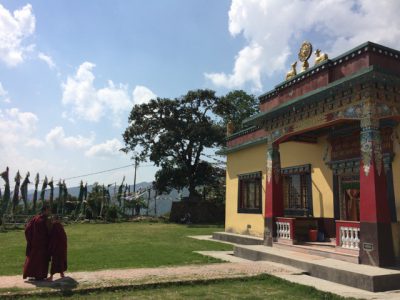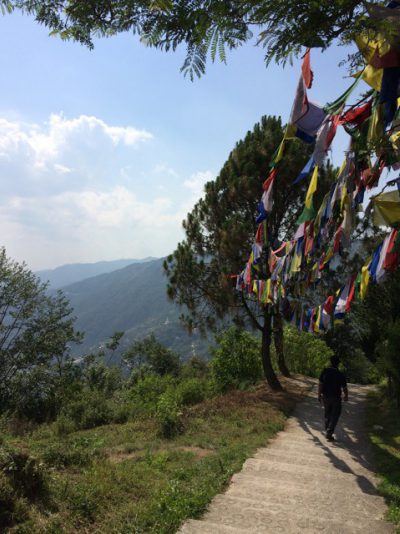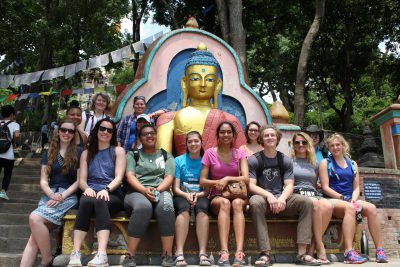Day One
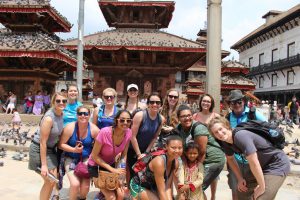
By Dr. Melinda Wilkins
Today was the first day of the One Health in Nepal Program. It is also Nepal’s National Election Day. As democracy is only 12 years old in Nepal, elections are taken very seriously. All roads were closed to vehicular traffic, so we decided it would be a great day to take in some cultural sights on foot. With Dr. Subir in the lead and myself bringing up the rear, we headed out early to Swayambhunath, otherwise known as the Monkey Temple.
The walk was hot and dusty, but well worth the effort! The temple is a beautiful celebration of the blending of both Hindu and Buddhist religions, and sits high on a hilltop overlooking Kathmandu Valley. True to its name, it was full of monkeys, prayer wheels, prayer flags, incredible temples, and one cow. After a lunch of chicken, buffalo and vegetable momos (dumplings), we headed to Kathmandu’s Durbar (Palace) Square. We were able to see the temple of the Living Goddess (Kamari Bahal) and a few others, but most of the area was closed due to the elections.
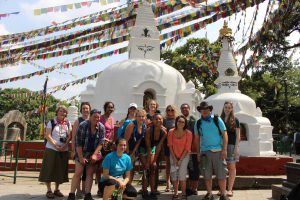
Evidence of the 2015 earthquake is everywhere with some historic buildings undergoing restoration, most propped up with beams and some just piles of rubble. Just walking in the old city was amazing with all the shops, street vendors, stray dogs, and small temples around every corner. The Kathmandu Guest House feels like a small, quiet oasis in the heart of the busy Thamel area of Kathmandu. Spicy food, sunburn, blisters, and slow or no Internet top our list of complaints, but are all very manageable. Tomorrow our more formal instruction begins!
Day Two
By Tim Dorman
We began the day with presentations from Mrs. Minu Sharma and Mr. Mani Ratra Aryai on food and water safety and how cultural traditions can contribute to food borne illnesses. We were able to learn more about Nepali culture and the importance of food and water safety to the citizens of the country. About half of the population drinks unsafe water, where up to 85 percent of their sources can be contaminated. We had the chance to ask questions to better understand this issue and discuss possible solutions.
In the afternoon, we toured the Infectious Disease Hospital and Central Laboratory. We bused there after lunch and first met up with Dr. Babu Ram Marasini, who gave us a tour of the laboratories. Some of the major pathogens they deal with in the laboratories are HIV and Avian Influenza. During the tour, we were able to ask about the specific pathogens we are researching.
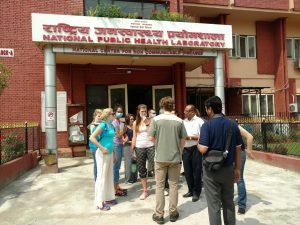
Afterwards, we met with Dr. Kharel to tour the hospital. As one of the two premedical students on the trip, I was excited to see how this hospital compared those in the US. There were definite differences including size, sanitization standards, and available resources. They just received their first CAT-scan machine this past year!
One interesting thing I learned—in Nepal, most healthcare is free. I thought that was amazing as it gives everyone the ability to receive medical care. At the end of the meeting, Dr. Kharel extended an invitation to myself and anybody interested to come back another day to shadow doctors in the ER and participate is rounds. I couldn’t pass up the opportunity, and I’ve already scheduled a return visit. I can’t wait.
Day Three
by Hannah Bernard
Today, we visited the National Animal Science Research Institute and talked about Nepal’s genetic sequencing and breeding for livestock. One of the breeds we learned about is the Lulu. Nepal has recently brought Lulu cattle down from the mountains. They are a smaller breed of cattle—smaller than even the Jerseys in the states. The Lulu cattle can produce between 1.5 and 2.5 liters of milk per day. The milk fat content is really high, as high as 6 percent, which makes it a good resource.
We then weaved our way through traffic to the Nepal Agricultural Research Council’s Animal Health Research Division. There, we discussed the zoonosis situation in Nepal. We found that TB and rabies are the most common diseases that are transferred from animals to humans and that they are the biggest problem right now.
After leaving the Animal Health Research Division, we traveled to a set of sacred temples. The temples had beautiful wood carvings and stone work, and I was very impressed with the integrity of the work, considering its age. The area itself was very clean, and it was also the first place that I had seen so much hand painted art. Most of it was of the mountains. Overall, it was another amazing day full of new experiences.
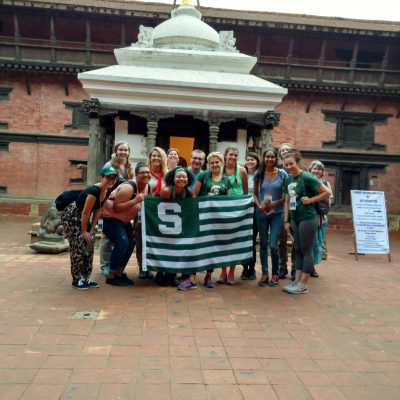
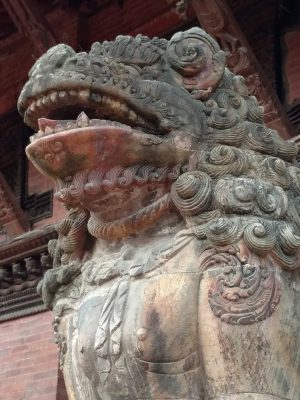
Day Four
by Rylee O'Brien
Our day began at 5:30 a.m. as we headed for a slaughter slab in Kathmandu. Personally, I didn’t know what to expect as I haven’t been around a lot of farms back in the states. After we were dropped off in town, we walked for a bit and stopped at a brick building where some water buffalo were tied up. We walked into the doorway and saw a few butchers carving the buffalo carcasses. Every part of the animal is used—even the feet. The whole process was crazy to see, especially because I had such a different picture in my head. Butchers were wearing normal clothes—sandals and jeans, and a woman even wore a skirt. The butchers also are trained to look for abnormalities like cysts in the meat, which may make it unhealthy for consumption. After the process was completed, the meat was ready to be sold to customers. It was incredible to experience this and to see how people in Nepal get their meat. I was expecting a big facility with people doing numerous quality control inspections, but because this slaughter slab was privatized, the government didn’t have any part in funding. We’ve been in Nepal for less than a week and already had so many incredible field trips. Although this wasn’t my favorite experience thus far and I may just become a vegetarian, I did learn a lot, and it was extremely interesting! Afterward, we traveled to a water treatment plant, where we learned about the purification process of drinking water.

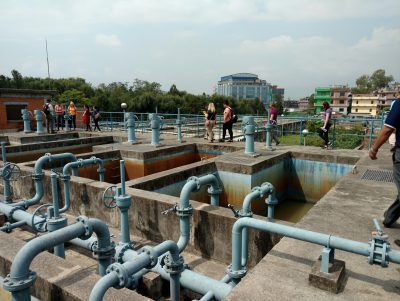
Day Five
by Nathan VanKley
Today, our group visited a dairy farm in the hills above Kathmandu Valley. We drove up a winding dirt road into the mountains with the sun at our backs. After an hour’s drive, we left the cars behind and hiked down the mountain to the dairy farm. On our half-hour hike, we were able to have our first experience with the rural community. It was amazing to see how little the people were provided with, and yet, they were happy. They were content with what they had—something we often take for granted.
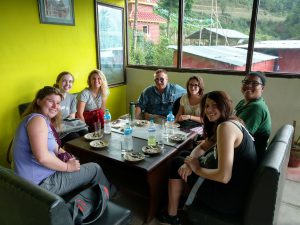
Occasionally, we would pass a group of children walking back from school and they would giggle and whisper amongst themselves. One of us would greet them with “Namaste,” and they’d all respond “Namaste!” with big smiles. At the end of our descent, we arrived at the dairy farm. Given the resources available, it was a surprisingly intensive system. Each cow had their own separate feed and water box, and they were tied up in rows for mobile mechanical milking. Milk was stored in individual tanks without cooling, and the milk truck would arrive every day to pick up the milk and take it to the dairy plant before it spoiled.
All the cattle on the premises were at least 68 percent Holstein or Jersey, and all were smaller cattle in good health condition. The cattle were fed a mixed ration of dried rice stalks, wheat, and maize grass. It was interesting to learn that the feed was never stored in bulk, but was always being harvested from the surrounding fields. The whole process is done on a daily basis, with no storage or preservation of the milk. I found this experience of touring the dairy farm to be a humbling one. I have a great appreciation for the dairy industry in Nepal and how hard the farmers work to provide food for their families.
Day Six
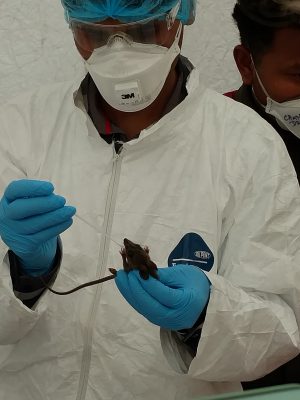
by Sidney Thigpen
During our sixth day of the program, we were able to take a tour of the Center for Molecular Dynamics Nepal. It is a lab that does genome research, specifically with endangered tigers. They also have research going on with aquatic animal biodiversity. I was really impressed with the facility, and appreciated that Lyman Briggs sent us to a biological lab where we were able to interact with the process of Polymerase Chain Reaction. This technique can be tedious and requires a lot of patience, but I am grateful that I was introduced to it. It opens up many doors when it comes to working in labs and research facilities.
We were also given a presentation by Dibesh Karmacharya, the chairman and executive director for the Center for Molecular Dynamics Nepal. Many of us were interested to see if they had labs in the United States. Unfortunately, they are only in Nepal, but they do offer internships. It was amazing to me that the officers were so open to having a few of us return to Nepal to work with their team for a few weeks. By doing so, we would get experiences in the lab, fieldwork, public health, and much more!
Day Seven
by Morgan Darter
We spent our day off visiting the Kathmandu Animal Treatment Centre (KAT Centre) and taking a hike in Shivapuri National Park. We want to experience as much of the Kathmandu Valley area as possible. At the animal shelter, we were greeted at the gate by a pack of dogs eager for attention. Having previously avoided any interaction with the street dogs in Kathmandu, we were all excited to be able to spend some time with the dogs. The pack was quite the cast of characters—there was Butterfly, who only had three legs, Lucky, who was missing an eye, Cardamom, who was quite content to sit with her eyes closed as Dr. Wilkins rubbed her head, and many others. There was one little black and white puppy who hadn’t been there long enough to get a name. The men at the center said we could name him, so naturally, we named him Sparty. What better name for a puppy? Along with the dogs, we met two men who worked at the center. They told us about their work as we sat in one of the rooms in the main house, although the dogs weren’t too happy that we’d left them.

The KAT Centre was opened in 2004 by Jan Salk, an artist who had a great love for the street dogs (or community dogs, as everyone in Nepal fondly refers to them). Since then, the KAT Centre has vaccinated 30,000 dogs and spayed and neutered 19,000 dogs. They have a Jeep that they use to travel and bring dogs in for surgery, sometimes doing mobile vaccine clinics. When the dogs come in, they are given a physical to see if they are fit for surgery. After surgery, they remain at the KAT Centre for a couple days to recover. They are released back to their territory sterilized, vaccinated, dewormed, and ear notched.
The people of Nepal have come to have more of an appreciation for the community dogs. The Nepali Government used to poison the dogs, a practice that has been stopped. Today, people from different areas will call the KAT Centre and request the dogs in their area be vaccinated, or sometimes will call if a dog is injured from something such as a car accident. The KAT Centre runs off of donations. The cost for one dog’s spay or neuter and vaccines is 2,500 Nepalese rupees or $25. Dogs that are handicapped in some way will remain at the KAT Centre. The costs for each dog’s care is around $150 per year.
When we visited, the Centre housed three feline residents in a small shed enclosure on top of one of their buildings. The cats are spayed or neutered and vaccinated, and were very friendly. The KAT Centre often adopts out some of their animals. This is not as common as it is in the United States, but it does happen. In Nepal, they have Kennel Clubs, and most residents would rather have a German Sheppard or Dalmatian rather than a Nepali dog. However, the Nepali community dogs do provide a service to the local area by providing protection. The KAT Centre also is offering some community education through clubs and schools. They are trying to change the public’s perception of community dogs and increase their knowledge of how to properly care for both personal pets and community dogs.
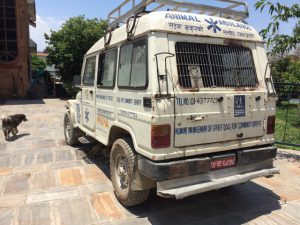
After learning about the work at the KAT Centre, we took a tour around the rest of their facility. We walked back past the “dog kitchen” to the row of kennels, careful not to step on any of the dogs that were soaking up the sun. The dogs in the kennels were mostly recovering from their sterilization surgeries. They all had labels on their runs noting which area in Kathmandu they had come from. As we walked along the row, we were greeted by another dog. Once we saw him, you could almost hear Sarah McLachlan playing in the background. He was almost entirely hairless from obvious mange with only a few tufts of thin hair remaining, and he had a fungal infection spreading from his shoulder. The worker said they called the dog Princess (we thought Prince Charming or Stephan would be more appropriate). He was being treated for his mange and the fungal infection, but with his personality, you wouldn’t have known he was sick. All he wanted was attention from everyone, and he put his paw on your leg if he wasn’t getting enough. Learning about the great work the Kat Centre does was a wonderful way to spend part of the afternoon.
We then drove to the entrance of Shivapuri National Park. We had a guide who took us up the wide trail. Going up, we got to experience some beautiful views of the valley and surrounding mountains. Halfway up, we met a group of workers clearing out the trench that followed the trail, allowing for adequate drainage. Lots of water later, we reached our destination: a Buddhist monastery. There were a lot of buildings in the complex. A few had colorful and detailed paint work. Like many things in Nepal, it was well worth the journey. And after the hike, we enjoyed—like we often do—some well-deserved momos.
